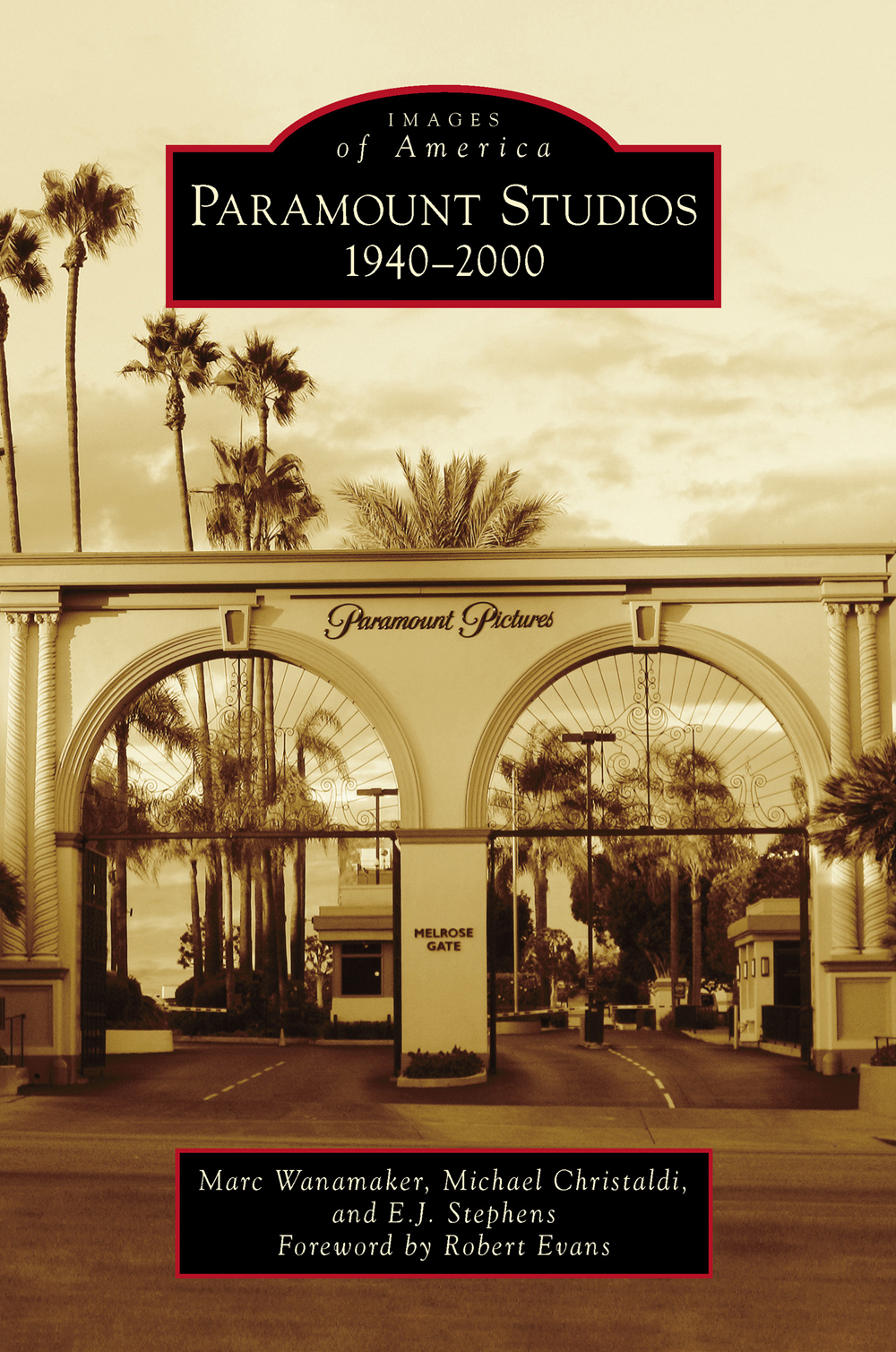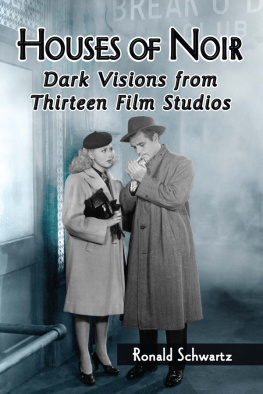
IMAGES
of America
PARAMOUNT STUDIOS
19402000

ADOLPH ZUKOR AND ROBERT EVANS. Paramount founder Adolph Zukor greets Robert Evans at a 1967 press conference announcing the appointment of Evans as Paramount Pictures head of production.
ON THE COVER: This photograph shows the Windsor Gate, as it appeared in 2000. (Photograph by Michael Christaldi.)
IMAGES
of America
PARAMOUNT STUDIOS
19402000
Marc Wanamaker, Michael Christaldi,
and E.J. Stephens
Foreword by Robert Evans

Copyright 2016 by Marc Wanamaker, Michael Christaldi, and E.J. Stephens
ISBN 978-1-4671-3494-1
Ebook ISBN 9781439655283
Published by Arcadia Publishing
Charleston, South Carolina
Library of Congress Control Number: 2015944923
For all general information, please contact Arcadia Publishing:
Telephone 843-853-2070
Fax 843-853-0044
E-mail
For customer service and orders:
Toll-Free 1-888-313-2665
Visit us on the Internet at www.arcadiapublishing.com
For Angela, who will someday write a better book of her own
Michael Christaldi
To Hollywood Heritage and the Lasky-DeMille Barn, where it all began
Marc Wanamaker
To Paramount Pictures, for giving us over 100 years of great memories
E.J. Stephens
CONTENTS
FOREWORD
American film is the only product made in this country that is number one throughout the world. It flies the American flag higher than any other export. Our industry deserves respect for that, and I for one am proud to be part of it.
Darryl Zanuck once told me if you can tell a story in a paragraph, you have a hit. If you can tell it in a sentence, you have a blockbuster! That very well might be true, but I can tell you with certainty that if it aint on the page, it aint on the screen. The property is king. That being said, filmmaking is essentially a collaborative effort.
This is a dynamic industry that is constantly in flux. Paramount has always made the moving picture, but the business of filmmaking changes from decade to decade. In the 1960s, the industry had been in decline for some time. It was losing money and finding it hard to relate to its new, younger audience. Many of the studios had already changed hands earlier in the decade, and Paramount was one of the last to make that generational leap. After Gulf + Western bought Paramount in 1966, Charles Bluhdorn approached me to run the studio. The status quo had been swept away, so we were given unprecedented freedom to revolutionize our product. Our approach was to use new or untapped talent to find a fresh voice that would speak to our changing audience. We set out to find the romance of the moment and to tell stories about how it feels.
A studio is a constantly creating artists workshop. Whether it be the cinematography, writing, directing, or acting, all of these things become pawns for those who control the magic of postproduction. Dailies are the takes selected by the producer, director, and cinematographer. They examine and cull out the best of the previous days filming. The director, being the captain of the ship, picks out his choices for the editor to assemble. Post-production is the most important element in the anatomy of filmmaking. It is an art unto itself and structures the arc of your story. Film, dialogue, sound, music, and effects are its five major tentacles, and during the post-production process, each of these are structured and edited separately by highly talented artistswhose contributions are rarely appreciated or spoken of. Frame by frame, with precision and skill, your canvas evolves its persona. Post-production is a key to film magic or film mediocrity. From it comes your completed canvas, which is presented for all of the world to see and critique.
Paramount was the first studio to make a full length feature film (Queen Elizabeth, 1912). Now, 103 years after its founding, it is the only major studio left in Hollywood, and under Sumner Redstones vision, it is stronger and more productive than ever. Looking through this book of wonderfully evocative photographs with Michael Christaldi, it naturally brings many personal memories to mind. Perhaps you could think of them as not just photographs of what was, but as a record of what still is... In a different time.

Robert Evans
June 12, 2015
Beverly Hills, California
ACKNOWLEDGMENTS
First and foremost, we would like to thank Robert Evans for taking the time to write the foreword for this book. In the 1960s, he brought Paramount out of the ashes and restored it to prominence. Without his foresight, this would be a much shorter read.
The authors would like to thank everyone at Arcadia Publishing for their hard work, especially Lily Watkins, Jeff Ruetsche, and David Mandel.
At Paramount Pictures, we would like to thank Jan Marie Johnson and her staff in guest relations: Kathy Coulter, Amy Lowry, Koranda Banks, Braden Yandle, Patrick Nicely, and Paramounts former guest relations managers Josh Jack and Bob Greg. Thanks also go to Jaci Rohr and Randall Thropp at Paramounts archives; Aaron J. Segal at the Water Tower; and Paramounts administrative concierge Kimberly Denny Pucci for her enthusiasm and help. And last but not least, thanks to the keepers of the gate, Paramount Security guards Mike Olguin and Nino Cicinelli for all their help and support.
Marc Wanamaker wishes to thank his coauthors, Michael Christaldi and E.J. Stephens, for their work and knowledge about Paramounts history. Thanks also to the Hollywood Heritage Museum and to Tommy Ryan for his rare photos. The authors thank Bison Archives for supplying most of the historical images for this book, which is a continuation of 2013s Early Paramount Studios.
Michael Christaldi: I would like to thank my daughter, Angela, for the million things she does to make me proud. Thanks go to my parents, Mario and Annamarie, for their constant love and support, and to my cousin Antonio J. Tronco, who is no longer with us but always believed in me and would have been proud to read this. I would also like to personally thank Robert Evans for taking the time to invite me into his home to work on this project. Most people never get to meet their idols, so it is a real thrill to be friends with mine. Thanks, Kid... I owe you one! Also, a big thank you to The Robert Evans Companys head of production, James Sikura, for being a friend; Alan Selka, for all his hard work and knowledge; and Michael Binns-Alfred and Alex Rio Bier for their assistance.
E.J. would like to thank his out-of-his-league wife, Kimi, for all of her love, support, and brilliant editing. He also wants to thank his kids, Mariah and Dylan, for their kindness, curiosity, humor, and overall awesomeness.
Unless otherwise noted, all photographs were provided by the Bison Archives and the Christaldi Collection.
INTRODUCTION
The turbulent Great Depression of the 1930s blighted the American economy and left the wreckage of entire industries in its wake. Hollywood, which many observers believed to be Depressionproof, felt the devastating effects just as much as any other company townwith the fallout affecting both stalwarts and startups.
Next page













